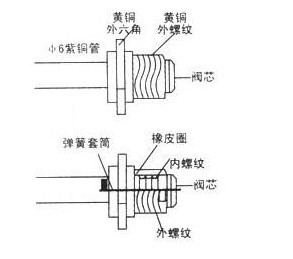When repairing high and low temperature test chambers at home, if there is a problem with improper fluoride addition, that is, “less fluorine†or “polyfluorinationâ€, bring a lot of maintenance tools. Vacuum pumps, welding tools, freon cylinders, tool kits... whichever is not the case, the total weight is seven or eighty pounds. If there is no car, it is not easy for two people to take these tools to the repair point. Today, the author came to explain to you, if you encounter the above faults, how to use the check valve. Buy a check valve, the structure is shown below. Remove the valve plug of the check valve and weld the check valve to the process tube of the high and low temperature test chamber. Make sure the welding is firm and leak-free, and then install the valve plug. When vacuuming, connect with a fluorinated tube with a thimble and the other end with an angle valve. Then connect the watch and the vacuum pump. After vacuuming, remove the vacuum pump and replace it with a fluorided steel bottle. After removing the angle valve (the second fluoride tube), add the air in the fluorine tube and add fluorine. After the fluorine is added, close the angle valve, remove the fluorine tube and the cylinder after the angle valve, and finally remove the fluorinated tube with the thimble on the check valve, and seal the check valve with the bulkhead. If the repaired high and low temperature test chambers have a "less fluorine" or "polyfluoride" failure, directly remove the bulkhead of the check valve and directly discharge fluorine or fluoride from the check valve spool. When repairing the door, you can avoid the maintenance of "heavy weapons" such as welding tools and vacuum pumps. The ideal size for a small running bag is 30 liters, which is big enough to hold the ten essentials and extras for a personal climb. running bag can be as small as 10 liters or as large as 40 to 50 liters. If you are a frequent leader or carry a teammate (or a child), you may need a running backpack of 40 liters or more. In most cases, a travel backpack capacity of 30 liters is a standard capacity and the most popular choice. But if your activities range from hiking in summer to skiing in winter, you may need more than one shoulder backpacks. Consider your needs to determine your shoulder sling bags choice. Sports Backpack,Polo Sport Backpack,Running Backpack,Running Bag Zhejiang Yinglin Luggage Co. Ltd , https://www.yllcluggage.com
How to use the check valve in the maintenance of high and low temperature test chamber